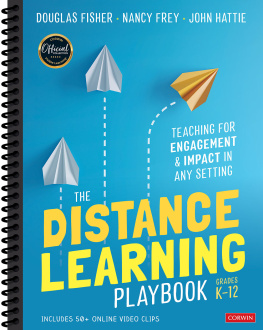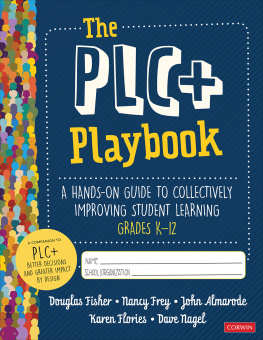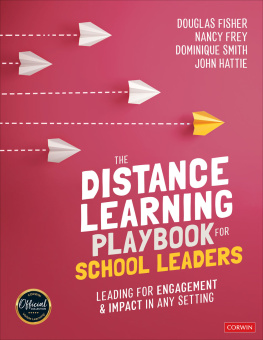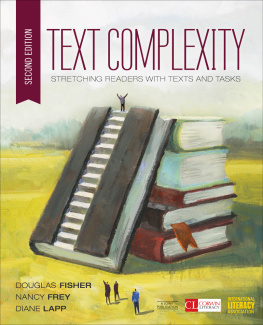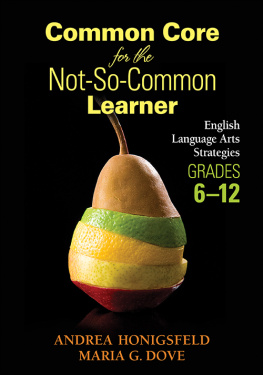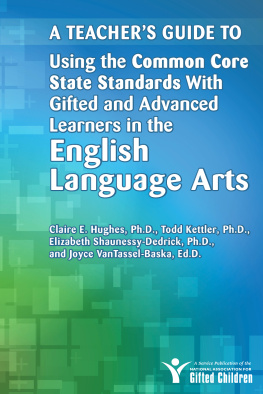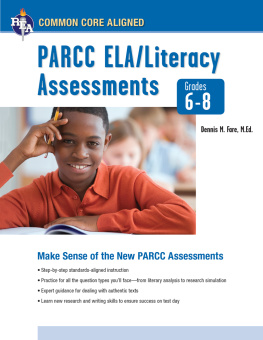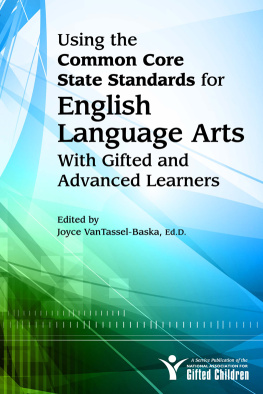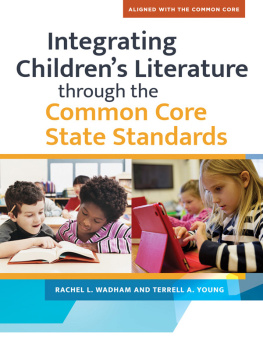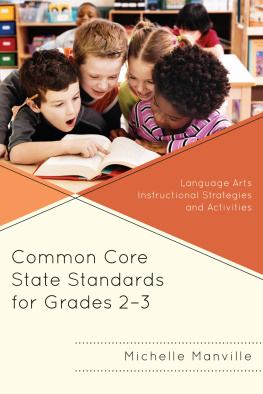COMMON CORE
English
Language
Arts
in a PLC at Work
GRADES K2
DOUGLAS FISHER
NANCY FREY
Foreword by Rebecca DuFour

Copyright 2013 by Solution Tree Press
Materials appearing here are copyrighted. With one exception, all rights are reserved. Readers may reproduce only those pages marked Reproducible. Otherwise, no part of this book may be reproduced or transmitted in any form or by any means (electronic, photocopying, recording, or otherwise) without prior written permission of the publisher.
555 North Morton Street
Bloomington, IN 47404
800.733.6786 (toll free) / 812.336.7700
FAX: 812.336.7790
email:
solution-tree.com
Visit go.solution-tree.com/commoncore to download the reproducibles in this book.
Printed in the United States of America
16 15 14 13 12 1 2 3 4 5
IRA Stock No. 9245

Library of Congress Cataloging-in-Publication Data
Fisher, Douglas, 1965
Common core English language arts in a PLC at work, grades K-2 / Douglas Fisher, Nancy Frey.
pages cm
A joint publication with IRA.
IRA Stock No. 9245.
Includes bibliographical references and index.
ISBN 978-1-936764-16-7 (perfect bound) 1. Language arts (Elementary)--Standards--United States. 2. Language arts (Elementary)--Curricula--United States. 3. Professional learning communities. I. Title.
LB1576.F4419 2013
372.6'044--dc23
2012038787
Solution Tree
Jeffrey C. Jones, CEO
Edmund M. Ackerman, President
Solution Tree Press
President: Douglas M. Rife
Publisher: Robert D. Clouse
Editorial Director: Lesley Bolton
Managing Production Editor: Caroline Wise
Senior Production Editor: Joan Irwin
Copy Editor: Sarah Payne-Mills
Proofreader: Elisabeth Abrams
Cover and Text Designer: Jenn Taylor
TABLE OF CONTENTS
ABOUT THE AUTHORS

Douglas Fisher, PhD, is a professor of educational leadership at San Diego State University and a teacher leader at Health Sciences High and Middle College. He teaches courses in instructional improvement. As a classroom teacher, Fisher focuses on English language arts instruction. He also serves as the literacy instructional advisor to the Chula Vista Elementary School District.
Fisher received an International Reading Association Celebrate Literacy Award for his work on literacy leadership and was elected to the board of directors in 2012. For his work as codirector of the City Heights Professional Development Schools, Fisher received the Christa McAuliffe award. He was corecipient of the Farmer Award for excellence in writing from the National Council of Teachers of English for the article, Using Graphic Novels, Anime, and the Internet in an Urban High School, published in the English Journal.
Fisher has written numerous articles on reading and literacy, differentiated instruction, and curriculum design. His books include In a Reading State of Mind, Checking for Understanding, Better Learning Through Structured Teaching, and Text Complexity.
He earned a bachelors degree in communication, a masters degree in public health education, and a doctoral degree in multicultural education. Fisher completed postdoctoral study at the National Association of State Boards of Education focused on standards-based reforms.
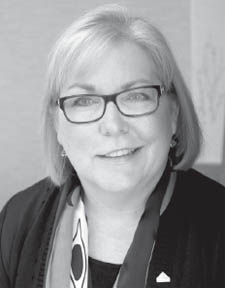
Nancy Frey, PhD, is a professor of literacy in the School of Teacher Education at San Diego State University. Through the universitys teacher-credentialing and reading specialist programs, she teaches courses on elementary and secondary reading instruction and literacy in content areas, classroom management, and supporting students with diverse learning needs. Frey also teaches at Health Sciences High and Middle College in San Diego. She was a board member of the California Reading Association and a credentialed special educator, reading specialist, and administrator in California.
Before joining the university faculty, Frey was a public school teacher in Florida. She worked at the state level for the Florida Inclusion Network helping districts design systems for supporting students with disabilities in general education classrooms.
She is the recipient of the 2008 Early Career Achievement Award from the National Reading Conference and the Christa McAuliffe Award for excellence in teacher education from the American Association of State Colleges and Universities. She was corecipient of the Farmer Award for excellence in writing from the National Council of Teachers of English for the article Using Graphic Novels, Anime, and the Internet in an Urban High School.
Frey is author of The Formative Assessment Action Plan, Productive Group Work, Teaching Students to Read Like Detectives, and Content-Area Conversations. She has written articles for The Reading Teacher, Journal of Adolescent and Adult Literacy, English Journal, Voices from the Middle, Middle School Journal, Remedial and Special Education, and Educational Leadership.
To book Douglas Fisher or Nancy Frey for professional development, contact .
FOREWORD
The publication of Common Core English Language Arts in a PLC at Work, Grades K2 could not be more timely as educators across the United States are gearing up to make the new standards the foundation of their English language arts (ELA) curriculum, instruction, assessment, intervention, enrichment, and professional development processes. The authors, Douglas Fisher and Nancy Frey, are not only two of the United States most highly regarded experts in ELA but are also educators who have a deep understanding of the steps needed to bring the Common Core standards to life in our classrooms. Fisher and Frey recognize that if students are going to learn these rigorous skills, concepts, and ways of thinking that are essential to their current and future success, then the educators serving those students must no longer work in traditional isolated classrooms but rather must work as members of collaborative teams in schools and districts that function as professional learning communities (PLCs). As the authors state on :
In fact, chances are good that you are interested in this book because it promises to link an important changeimplementing the Common Core State Standards in English language artswith a process you already know to be powerful: professional learning communities.
Picture an elementary teacher working in a traditional school. He or she will likely be provided a copy of the Common Core State Standards document, may receive a few hours of training from someone in the district, and then essentially will be left to work in isolation for the rest of the year to interpret, teach, and assess each standard to the best of his or her ability. The degree to which the students assigned into that traditional classroom learn each standard will almost exclusively depend on that teachers understanding of each standard, how much time and energy he or she is able and willing to devote to the new standards, and finally, his or her ability to teach the standards effectively.


